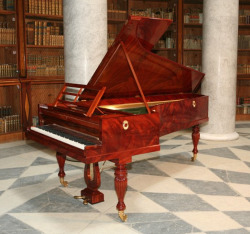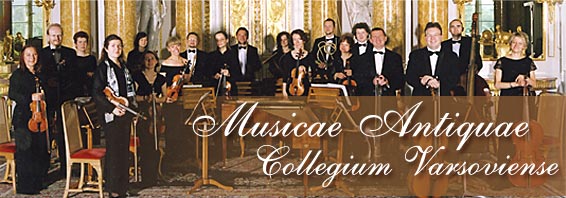![]()
"THE ONLY SUCH COPY IN THE WORLD"
The talk with the directors of the Warsaw Chamber Opera - Stefan Sutkowski, Edward Pałłasz and Krzysztof Kur

Replica of 1830 Pleyel piano,
made by Paul McNulty
for the Warsaw Chamber Opera
Stefan Sutkowski: Listening to Chopin today, the impression is that the music is not represented convincingly on modern instruments. The modern concert grand piano is the product of an epoch very remote to the time of Chopin’s music and the romantic music of his period. You can not draw far-reaching conclusions about Chopin’s playing - requiring an instrument highly refined in the formation of tone, in producing legato and technical proficiency - if the only available instruments from his time are a few worn-out originals. The same applies to the music of Mozart: we could only approach performing and recording the keyboard concertos by making a copy of a Walter piano; similarly, the only chance to hear how a piano on which Chopin played might sound was to build a copy of the piano that he used in his time – an instrument similar to the piano about which Chopin wrote with great enthusiasm, and used two months later for his successful debut at the Salle Pleyel in Paris.
We wanted to be as close as possible to the truth, so we asked to make for us a copy of a representative instrument of 1830 or - if not possible - 1831. Wondering who could make such a copy, we thought of Paul McNulty, with whom we already had excellent cooperation when we ordered a Mozart instrument. The requisite tender procedure very strictly specified that the builder must approve a high technical and organological regard for the instrument he should copy. McNulty was the only bidder who met our conditions, and the negotiated price - although high for us - turned out to be acceptable and also possible to cover by funds earned by the Warsaw Chamber Opera.
We are delighted to be part of the world's first attempt to build a copy of such a piano. We had a sure feeling because Paul McNulty found an instrument that would serve as a model to construct our copy; also we knew that during the construction of our instrument it would be monitored on an ongoing basis by Paul’s wife Viviana Sofronitsky, a fortepianist with extensive experience in playing such instruments.
Paul McNulty took part in the selection process. He explored one Pleyel, a concert model, in a museum of instruments in Brussels, but then he found an ideal example in a Paris museum, and finally modeled his copy after this.
Krzysztof Kur: - In the tender documents, however, was specified a copy of the instrument from Brussels, because at the beginning we did not know that the Paris example would meet our criteria even better. We thought at first it would be an instrument from 1831, but research in the Pleyel archives showed that "our" Pleyel instrument is modeled after a concert grand, serial number 1555, completed in 1830, and in July of the same year delivered to Mr de Villermay. Nice to know who played on it.
Stefan Sutkowski: It's an unusual story, of course: together with Paul McNulty we were at risk that the project might fail. The instrument was built in one and a half years because making such a piano is much more difficult than building a copy of Walter fortepiano or pianos of Walter’s time. The Pleyel from 1830 is mechanically much closer to our times than to eighteenth-century technology. When we heard this instrument, we were not surprised that Chopin spoke of Pleyel’s pianos so highly, and preferred them always for his personal use and for concertizing. The project for our piano was structurally well thought through and had also to be well executed in order for the copy to be so interesting.
Edward Pallasz: The starting part of the work was made in Poland, producing the cast iron piano frame parts. There is still in our country the knowledge of how to cast iron according traditional technology.
Krzysztof Kur: My visit to Paul McNulty’s workshop, in Divisov near Prague, moved me in time. I felt I was looking at an early nineteenth century factory, however bright with lights. For making some big parts there were sometimes up to six people working to help Paul; all parts there were made manually, by procedures and practices observable in antique examples. I saw the case of a Pleyel piano from the 1830’s, which Paul had bought in Rotterdam from a dealer of old pianos. The case was in such bad state that it was not possible to restore, but priceless for study. It turned out that the outer case is made of oak boards 20 mm thick, on which - to increase rigidity –each side has glued 2-mm oak facing across the grain, and all together covered with ornate mahogany veneer. From the outside, measuring in a museum, it was impossible to see these details. Within the structure is a large curved member holding the soundboard and strings, comprised of three 20mm oak layers, made pliable with steam and clamped with massive force onto a curved form.
Stefan Sutkowski: Concerts planned on a copy of Pleyel piano require an orchestra from the time of Chopin. This orchestra is our Musica Antiqua Collegium Varsoviense – which has always played only on historical instruments. The orchestra was founded in 1957. Now the orchestra is preparing itself to perform on instruments from the first period of the Romantic era, the Pleyel /McNulty fortepiano giving the reference for concert pitch, so everything will be kept according to these lines. We will also use music scores from Chopin's time, such as the Variations on Mozart's Op. 2, or from the time closer to this period. We want to be the most authentic, with concert scores much older than those used nowdays, e.g. Fitelberg editions. In our theater, et al., Solidarity had already launched the Chopin Year. The premises provided by our Lions Club already organized an evening dedicated to the music of Chopin. Seven Songs of Chopin were sung there by Olga Pasichnyk, in partnership with Eve Pelweckiej; their interpretations were extraordinary, beautiful and moving. Key Warsaw Chamber Opera concerts are planned for 28, 29 and 30 September in the Great Hall of the Royal Castle. In each of them will be a piece for piano and orchestra with some additional pieces. Together with the Chopin Variations on Mozart's "Là ci darem la mano," Op. 2, will be performed the actual duet "Là ci darem la mano" from Don Giovanni, sung by Marta Boberska and Robert Gierlach, who will appear in opera costumes before and after the execution of Chopin's Variations by Viviana Sofronitsky. On the second day Natalia Pasichnyk will perform Concerto in E minor by Chopin, before which will be sounded the overture to the opera “Two Cottages” by Kurpinski. The third evening will feature the Concerto in F minor, performed by Janusz Olejniczak, preceded by the Concert Overture by Ignacy Feliks Dobrzynski. Collegium Musica Antiqua Varsoviense Orchestra will be led by Kai Bumann. We are thinking of recording all these works and to release CD albums.
Edward Pallasz: There is also a frame around these events. Some days before the concerts with Chopin's music will be performed the Passion by Joseph Elsner in the Evangelical Church. Elsner premiered the work in this church. Passions were a familiar concert form, and Chopin, when he was in Paris, tried to have his beloved teacher’s work published, showing how he valued it. On October 1 and 2 in our theater is also scheduled “Halka” in its Vilnius version.
Stefan Sutkowski: Our piano is the only such copy in the world. Paul McNulty is building a second instrument, but does not intend to sell it, saying that the price would have be more than one hundred thousand euros, i.e., the price of modern concert instrument. Our piano is obliged to be used on many occasions - festivals, courses, musicological seminars -because the main motive is interest to find out how Chopin's music sounded in the time when he himself was performing. We might not be able to restore all manners of his playing, maybe not his subtlety and freedom, but we can get closer to the sound palette which he had at his disposal. On most original fortepianos of the time playing is possible only with difficulty, and their sound capabilities are limited. By using a new copy, we can try to overcome these limitations, because possibly our instrument is sounding closer to the original than the two hundred year old originals.
